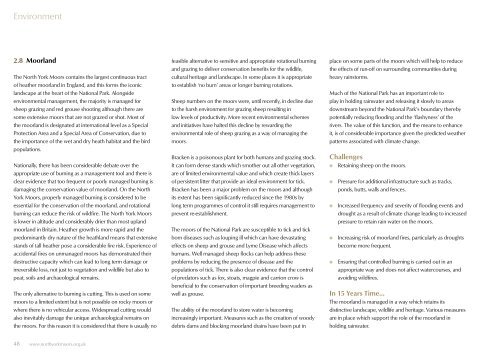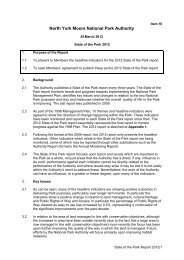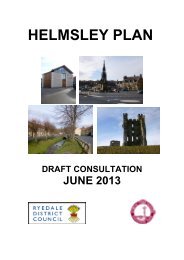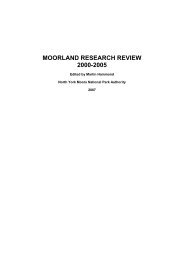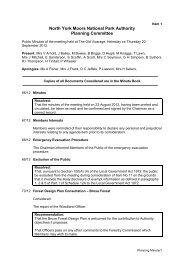Management Plan - North York Moors National Park
Management Plan - North York Moors National Park
Management Plan - North York Moors National Park
You also want an ePaper? Increase the reach of your titles
YUMPU automatically turns print PDFs into web optimized ePapers that Google loves.
Environment2.8 MoorlandThe <strong>North</strong> <strong>York</strong> <strong>Moors</strong> contains the largest continuous tractof heather moorland in England, and this forms the iconiclandscape at the heart of the <strong>National</strong> <strong>Park</strong>. Alongsideenvironmental management, the majority is managed forsheep grazing and red grouse shooting although there aresome extensive moors that are not grazed or shot. Most ofthe moorland is designated at international level as a SpecialProtection Area and a Special Area of Conservation, due tothe importance of the wet and dry heath habitat and the birdpopulations.<strong>National</strong>ly, there has been considerable debate over theappropriate use of burning as a management tool and there isclear evidence that too frequent or poorly managed burning isdamaging the conservation value of moorland. On the <strong>North</strong><strong>York</strong> <strong>Moors</strong>, properly managed burning is considered to beessential for the conservation of the moorland, and rotationalburning can reduce the risk of wildfire. The <strong>North</strong> <strong>York</strong> <strong>Moors</strong>is lower in altitude and considerably drier than most uplandmoorland in Britain. Heather growth is more rapid and thepredominantly dry nature of the heathland means that extensivestands of tall heather pose a considerable fire risk. Experience ofaccidental fires on unmanaged moors has demonstrated theirdestructive capacity which can lead to long term damage orirreversible loss, not just to vegetation and wildlife but also topeat, soils and archaeological remains.The only alternative to burning is cutting. This is used on somemoors to a limited extent but is not possible on rocky moors orwhere there is no vehicular access. Widespread cutting wouldalso inevitably damage the unique archaeological remains onthe moors. For this reason it is considered that there is usually nofeasible alternative to sensitive and appropriate rotational burningand grazing to deliver conservation benefits for the wildlife,cultural heritage and landscape. In some places it is appropriateto establish ‘no burn’ areas or longer burning rotations.Sheep numbers on the moors were, until recently, in decline dueto the harsh environment for grazing sheep resulting inlow levels of productivity. More recent environmental schemesand initiatives have halted this decline by rewarding theenvironmental role of sheep grazing as a way of managing themoors.Bracken is a poisonous plant for both humans and grazing stock.It can form dense stands which smother out all other vegetation,are of limited environmental value and which create thick layersof persistent litter that provide an ideal environment for tick.Bracken has been a major problem on the moors and althoughits extent has been significantly reduced since the 1980s bylong term programmes of control it still requires management toprevent re-establishment.The moors of the <strong>National</strong> <strong>Park</strong> are susceptible to tick and tickborn diseases such as louping ill which can have devastatingeffects on sheep and grouse and Lyme Disease which affectshumans. Well managed sheep flocks can help address theseproblems by reducing the presence of disease and thepopulations of tick. There is also clear evidence that the controlof predators such as fox, stoats, magpie and carrion crow isbeneficial to the conservation of important breeding waders aswell as grouse.The ability of the moorland to store water is becomingincreasingly important. Measures such as the creation of woodydebris dams and blocking moorland drains have been put inplace on some parts of the moors which will help to reducethe effects of run-off on surrounding communities duringheavy rainstorms.Much of the <strong>National</strong> <strong>Park</strong> has an important role toplay in holding rainwater and releasing it slowly to areasdownstream beyond the <strong>National</strong> <strong>Park</strong>’s boundary therebypotentially reducing flooding and the ‘flashyness’ of therivers. The value of this function, and the means to enhanceit, is of considerable importance given the predicted weatherpatterns associated with climate change.Challenges● Retaining sheep on the moors.● Pressure for additional infrastructure such as tracks,ponds, butts, walls and fences.● Increased frequency and severity of flooding events anddrought as a result of climate change leading to increasedpressure to retain rain water on the moors.● Increasing risk of moorland fires, particularly as droughtsbecome more frequent.● Ensuring that controlled burning is carried out in anappropriate way and does not affect watercourses, andavoiding wildfires.In 15 Years Time…The moorland is managed in a way which retains itsdistinctive landscape, wildlife and heritage. Various measuresare in place which support the role of the moorland inholding rainwater.48 www.northyorkmoors.org.uk


